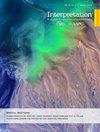用于裂缝前沿探测的低频分布式声学传感形状因子
IF 1
4区 地球科学
Q3 GEOCHEMISTRY & GEOPHYSICS
Interpretation-A Journal of Subsurface Characterization
Pub Date : 2023-03-01
DOI:10.1190/int-2022-0100.1
引用次数: 0
摘要
对多阶段非常规完井中产生的裂缝范围的准确了解仍然难以捉摸。井间低频分布式声学传感(LF-DAS)测量可以确定压裂命中的时间和位置。知道压裂命中发生的地点和时间会限制压裂程度,但不能定量估计。最近一项关于井间LF-DAS的研究表明,当压裂命中时,可以快速确定瞬时裂缝扩展速率。这种方法,即零应变速率定位法(ZSRLM),基于实验室实验和假设径向断裂几何形状的数值建模。估计的裂缝扩展速度可用于推断最终裂缝范围。传播速率是基于从光纤到传播裂缝前部的最近距离的动态估计来计算的。在这项工作中,ZSRLM适用于基于矩形裂缝几何形状来估计到裂缝前缘的距离。三维位移不连续性方法程序生成考虑恒定高度的单个矩形裂缝的井间LF-DAS应变速率瀑布图。对不同的地层力学性质、裂缝高度以及处理井和监测井之间的垂直和水平偏移进行了30多种不同的模拟。对于每个模拟情况,ZSRLM用于基于模拟瀑布图来估计到裂缝前缘的距离。到前方的估计距离和实际距离之间的差异通过形状因子最小化。确定了形状因子、裂缝高度比和垂直偏移率之间的关系。对于矩形裂缝,使用形状因子可将ZSRLM的性能提高两倍。更新后的ZSRLM用于推断两种现场情况下的最终裂缝范围:Montney组的单集群阶段和Austin Chalk完井的多集群阶段。本文章由计算机程序翻译,如有差异,请以英文原文为准。
Low-frequency distributed acoustic sensing shape factors for fracture front detection
Accurate knowledge of fracture extents generated in multistage unconventional completions remains elusive. Crosswell low-frequency distributed acoustic sensing (LF-DAS) measurements can determine the time and location of a frac hit. Knowing where and when a frac hit occurs constrains the fracture extent but does not estimate it quantitatively. A recent study on crosswell LF-DAS demonstrated a simple method to rapidly determine the instantaneous fracture propagation rate when a frac hit occurs. This method, the zero strain rate location method (ZSRLM), is based on laboratory experiments and numerical modeling assuming a radial fracture geometry. An estimated fracture propagation velocity can be used to extrapolate a final fracture extent. The propagation rate is calculated based on dynamic estimates of the nearest distance from the fiber to the front of a propagating fracture.In this work, the ZSRLM is adapted to estimate the distance to the fracture front based on rectangular fracture geometries. A three-dimensional displacement discontinuity method program generates crosswell LF-DAS strain rate waterfall plots considering a single, rectangular fracture of constant height. Over thirty different simulations were conducted varying formation mechanical properties, fracture height, and the vertical and horizontal offset between the treatment and monitor well. For each simulated case, the ZSRLM is used to estimate the distance to the fracture front based on the simulated waterfall plots. The difference between the estimated and actual distance to the front is minimized by a shape factor. The relationship between the shape factor, fracture height ratio, and vertical offset ratio is determined. Using a shape factor improves the performance of the ZSRLM by up to a factor of two for rectangular fractures. The updated ZSRLM is applied to extrapolate final fracture extents in two field cases: a single cluster stage in the Montney formation and a multi-cluster stage of an Austin Chalk completion.
求助全文
通过发布文献求助,成功后即可免费获取论文全文。
去求助
来源期刊

Interpretation-A Journal of Subsurface Characterization
GEOCHEMISTRY & GEOPHYSICS-
CiteScore
2.50
自引率
8.30%
发文量
126
期刊介绍:
***Jointly published by the American Association of Petroleum Geologists (AAPG) and the Society of Exploration Geophysicists (SEG)***
Interpretation is a new, peer-reviewed journal for advancing the practice of subsurface interpretation.
 求助内容:
求助内容: 应助结果提醒方式:
应助结果提醒方式:


